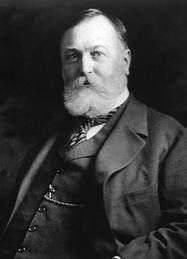Clarence W. Barron
Clarence W. Barron (July 2, 1855, in Boston, Massachusetts – October 2, 1928) is one of the most influential figures in the history of Dow Jones & Company. As a career newsman described as a "short, rotund powerhouse",[1] he died holding the posts of president of Dow Jones and de facto manager of The Wall Street Journal. He is considered the founder of modern financial journalism.
Clarence W. Barron | |
|---|---|
 | |
| Born | July 2, 1855 Boston, Massachusetts, U.S. |
| Died | October 2, 1928 (aged 73) |
| Occupation | Financial journalist |
| Spouse(s) | Jessie M. Waldron |
| Children | 2 adopted daughters (Jane & Martha) |
| External image | |
|---|---|
Early life
Barron graduated from Boston English high school in 1873.
Career
Barron worked at a number of newspapers throughout his life, including the Boston Daily News and the Boston Evening Transcript, the latter from 1875 to 1887. He founded the Boston News Bureau in 1887 and the Philadelphia News Bureau in 1897, supplying financial news to brokers.
In March 1903, Barron purchased Dow Jones & Company for $130,000, following the death of co-founder Charles Dow. In 1912, he appointed himself president, a title he held until his death and one which allowed him control of The Wall Street Journal, while the Woodworths published the paper. He expanded the reach of his publishing empire by merging his two news bureaus into Dow Jones. By 1920, he had expanded the daily circulation of The Wall Street Journal from 7,000 to 18,750, and over 50,000 by 1930. He also worked hard to modernize operations by introducing modern printing presses and expanding the reporting corps.
Barron also established the financial advertising agency Doremus & Co. in 1903.[2] In 1921, he founded the Dow Jones financial journal, Barron's National Financial Weekly, later renamed Barron's Magazine, and served as its first editor. He priced the magazine at 10 cents an issue and saw circulation explode to 30,000 by 1926, with high popularity among investors and financiers.
Personal life
Barron married Jessie M. Waldron in 1900 and adopted her daughters, Jane and Martha. Mrs. Barron died in 1918. After Jane married Hugh Bancroft in 1907, Barron became a prominent member of the Boston Brahmin Bancroft family. Martha Barron married H. Wendell Endicott, heir apparent to the Endicott Shoe Company. Mr. & Mrs. Barron and the Endicotts are buried in a joint family plot at the historic Forest Hills Cemetery in the Jamaica Plain neighborhood of Boston.
Legacy
After his death, Barron's responsibilities were split between his son-in-law Hugh Bancroft, who became president of Dow Jones, and his friend Kenneth C. Hogate, who became the managing editor of the Journal.
They Told Barron (1930) and More They Told Barron (1931), two books edited by Arthur Pound and S. T. Moore were published that showed his close connections and his role as a confidant to top financiers from New York City society, such as Charles M. Schwab. As a result, he has been called "the diarist of the American Dream." (Reutter 148) This has led to allegations that he was too close to those he covered.
However, Barron was renowned for pushing for deep scrutiny of corporate financial records, and is thus considered the founder of modern financial journalism. Barron's personal credo, which he supposedly urged the Journal to print and follow, was "The Wall Street Journal must stand for what is best in Wall Street." For example, in 1913, he gave testimony to the Massachusetts Public Service Commission regarding a slush fund held by the New Haven Railroad. In 1920 he investigated Charles Ponzi, inventor of the Ponzi scheme, for the Boston Post. His aggressive questioning and common-sense reasoning helped lead to Ponzi's arrest and conviction.[3]
The Bancroft family remained the majority shareholder of Dow Jones until July 31, 2007 when Rupert Murdoch's News Corp. won the support of 32 percent of the Dow Jones voting shares controlled by the Bancroft family, enough to ensure a comfortable margin of victory.
Trivia
- He helped endow the Clarke School for the Deaf with two million dollars, and proposed naming it the Coolidge Trust after President Calvin Coolidge and his wife Grace. (Roberts 225)
- Clarence W. Barron's former Boston mansion is located at 334 Beacon Street, on the banks of the Charles River. The property was converted into condominiums in the 1980s. Since 2007 a portrait of Clarence W. Barron has been prominently displayed on the parlor level of the former mansion.
Books
- The Boston Stock Exchange (1893)
- Federal Reserve Act (1914)
- The Audacious War (1915)
- The Mexican Problem (1917)
- War Finance, As Viewed From the Roof of the World in Switzerland (1919)
- World Remaking; or, Peace Finance (1920)
- Lord's Money (1922)
- Twenty-Eight Essays on the Federal Reserve Act (unk.)
- My Creed (unk.)
- They Told Barron (1930)
- More They Told Barron (1931)
References
- Robert McG. Thomas, Jr., "Mary Bancroft Dead at 93; U.S. Spy in World War II", The New York Times, January 19, 1997. (The subject of this Times obituary was Barron's step-granddaughter.)
- Sold to BBDO in 1974, Doremus became a unit of Omnicom in 1986. "Doremus & Co.", Advertising Age Encyclopedia, September 15, 2003.
- The Confidence Artists at www.vectorsite.net
- Roberts, John B. Rating the First Ladies. ISBN 0-8065-2608-4
- Reutter, Mark. Making Steel. ISBN 0-252-07233-2
External links
| Wikisource has original text related to this article: |